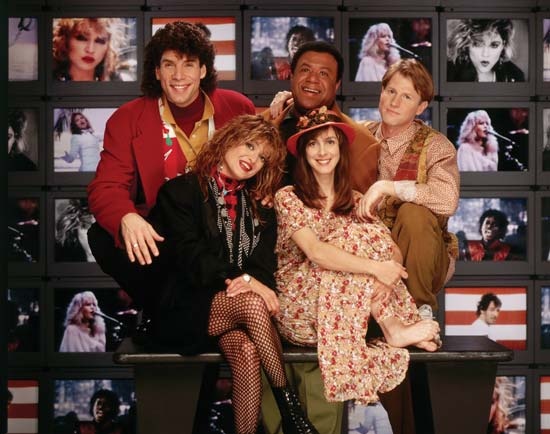MTV
cable television network
in full Music Television
 cable television network that began as a 24-hour platform for music videos (music video).
cable television network that began as a 24-hour platform for music videos (music video).MTV debuted just after midnight on Aug. 1, 1981, with the broadcast of "Video Killed the Radio Star" by the Buggles. Following the format of Top 40 radio, video disc jockeys (or “veejays”) introduced videos and bantered about music news between clips. After an initial splash, the network struggled in its early years. The music video reservoir was still somewhat shallow, resulting in frequent repetition of clips, and cable television remained a luxury that had not quite found its market. MTV expanded its programming to include rhythm and blues artists, and the network took off. Singles such as "Billie Jean" and "Beat It" from Michael Jackson (Jackson, Michael)'s Thriller (1982) not only showcased the strengths of the music video format but proved that exposure on MTV could propel artists to superstardom.
 The network brought success to such newcomers as Madonna and new wave icons Duran Duran, who used increasingly sophisticated techniques to make the visual elements of the video as important as the music. MTV also gave renewed life to veteran performers such as ZZ Top, Tina Turner (Turner, Tina), and Peter Gabriel (Gabriel, Peter), each of whom scored the biggest hits of their careers thanks to heavy rotation of their videos. By the mid-1980s, MTV had produced a noticeable effect on motion pictures, commercials, and television. It also changed the music industry; looking good (or at least interesting) on MTV became as important as sounding good when it came to selling recordings.
The network brought success to such newcomers as Madonna and new wave icons Duran Duran, who used increasingly sophisticated techniques to make the visual elements of the video as important as the music. MTV also gave renewed life to veteran performers such as ZZ Top, Tina Turner (Turner, Tina), and Peter Gabriel (Gabriel, Peter), each of whom scored the biggest hits of their careers thanks to heavy rotation of their videos. By the mid-1980s, MTV had produced a noticeable effect on motion pictures, commercials, and television. It also changed the music industry; looking good (or at least interesting) on MTV became as important as sounding good when it came to selling recordings.In 1985 entertainment conglomerate Viacom Inc. purchased MTV Networks, the parent corporation of MTV, from Warner Communications Inc., and the shift in content was both dramatic and immediate. Instead of free-form playlists of music that covered a veejay's entire shift, videos were packaged into discrete blocks based on genre. This gave rise to specialty shows such as 120 Minutes ( alternative rock), Headbangers Ball ( heavy metal), and Yo! MTV Raps ( hip-hop). Before long, game shows, reality shows, animated cartoons, and soap operas began to appear in the MTV lineup, and the network shifted its focus from music to youth-oriented pop culture.
By the mid-1990s, the majority of MTV's daily schedule was devoted to programming that was not related to music. Its sister station VH1 had been broadcasting adult-oriented rock videos since 1985, and it soon filled the vacuum, with original content such as Pop Up Video and the documentary series Behind the Music. MTV Networks launched MTV2 in 1996, with the intention of recapturing the spirit that had led millions in the 1980s to demand, “I want my MTV.” MTV2 started with the same free-form structure that characterized early MTV, but it soon shifted to genre-specific programs. By 2005 MTV2 had followed the same course as its parent network, with the bulk of its schedule consisting of reality shows, celebrity coverage, and comedies.
While music had a reduced presence on MTV, videos remained important to the network and its image. Beginning in 1984, MTV honoured achievement in the format with its annual Video Music Awards. Total Request Live (TRL), an hour-long interview and music video show, debuted in 1998 and anchored the weekday lineup. By the early 21st century, however, MTV increasingly sought to position itself as a destination for music on the Internet. Its Web site offered streaming video and audio content, and in 2007 it launched Rhapsody America, a joint venture with RealNetworks and Verizon Wireless, as a subscription-based alternative to Apple Inc.'s wildly popular iTunes service. Partly because of the popularity of viewing music videos on the Internet, TRL was cancelled in 2008.
- personality assessment
- personality disorder
- personal-liberty laws
- personification
- perspective
- perspective scenery
- perspiration
- Persson, Göran
- persuasion
- Per Teodor Cleve
- Perth
- Perth Amboy
- Perth and Kinross
- perthite
- Perthshire
- Pertinax, Publius Helvius
- Pertini, Alessandro
- Pertti Karppinen
- perturbation
- Peru
- Peru-Chile Trench
- Peru Current
- Peru, flag of
- Perugia
- Perugia, University of